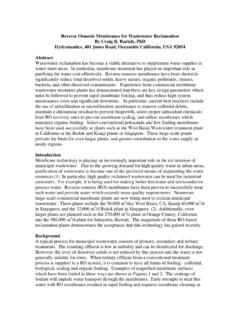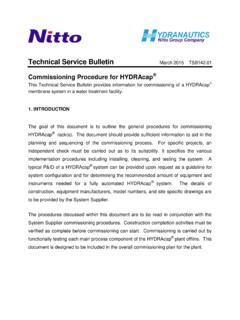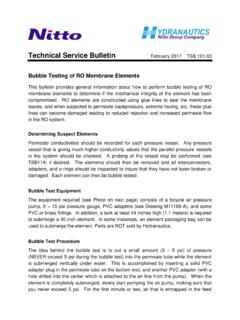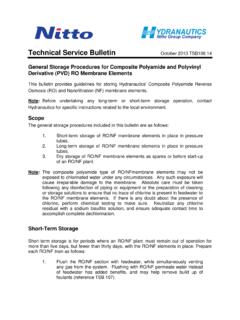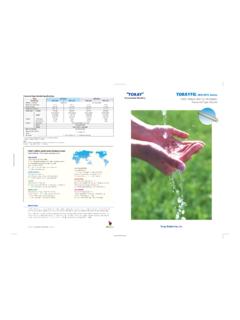Transcription of Chemical Pretreatment For RO and NF
1 Chemical Pretreatment For RO and NF October 2013 401 Jones Road, Oceanside, CA 92058 Phone: Fax: There are a number of chemicals that can be introduced into the RO feed to enhance the Technical Application Bulletin No. 111 Page 2 of 16 operation of the RO system. Acids Caustic Dechlorination chemicals Antiscalants and Dispersants Acids: Acids, typically hydrochloric [HCl] or sulfuric [H2SO4], are injected into the RO feed to lower pH.
2 Sulfuric acid is used more often than HCl acid. One reason for this is because sulfuric acid is relatively lower in operating cost than HCl acid. Another advantage to using sulfuric over HCl is the reduced fuming to the atmosphere, which means less corrosion to surrounding metal components. Sulfuric acid is sometimes preferred over HCl since there is a better membrane rejection of the sulfate ion than the chloride ion. Technical grade sulfuric acid, with no other additives, is suitable for use with a RO. Sulfuric acid is commercially available as a 20% and 93% solution.
3 The 93% solution is also referred to as 66 0 Baume solution . Caution is required in diluting 93% sulfuric acid, since the maximum heat of dilution of about 280 F occurs around 60%. It is critical that the concentrated acid is added slowly to the top of dilution water that is being agitated to minimize the buildup of heat and boiling of the makeup solution. Hydrochloric acid is preferred when calcium sulfate, barium sulfate, or strontium sulfate scaling is a concern. Sulfuric acid increases the sulfate ion level in the RO feed, which directly increases the potential for sulfate-based scaling.
4 Technical grade hydrochloric acid (with no additives) is typically suitable for purchase. HCl acid is typically available as a 30 to 37% solution. It is sometimes referred to as muriatic acid. The primary purpose for reducing the feed pH is to reduce the potential of calcium carbonate scaling in the RO concentrate as measured by using the Langlier Saturation Index [LSI]. LSI is a method of reporting the scaling or corrosive potential of low TDS brackish water based on the level of saturation of calcium carbonate [CaCO3]. LSI is important in RO water chemistry in determining whether water will or will not form calcium carbonate scale.
5 Water with a negative LSI is considered corrosive to metal piping and will not form calcium carbonate scale. Water with a positive LSI is not corrosive, but it will tend to form calcium carbonate scale. The LSI value is calculated by subtracting the calculated pH of saturation of calcium carbonate from the actual feed pH. Calcium carbonate solubility decreases with increasing temperature Technical Application Bulletin No. 111 Page 3 of 16 (as evidenced by the liming of a tea kettle), higher pH, higher calcium concentration, and higher alkalinity levels.
6 The LSI value can be lowered by reducing pH by the injection of an acid (typically sulfuric or hydrochloric) into the RO feed water. A recommended target LSI in the RO concentrate is negative (which indicates that the concentrate is pH units below the point of calcium carbonate saturation). A negative LSI allows for pH excursions in actual plant operation. A polymer-based antiscalant can also be used to inhibit the precipitation of calcium carbonate. Some antiscalant suppliers have reported the efficacy of their product up to a positive LSI value of in the RO concentrate (though a more conservative design LSI level is + ).
7 Caustics Caustics, for a few process applications, can be injected to increase the RO feed pH. Typically the only caustic injected is sodium hydroxide [NaOH] based on its cost, its availability, and its solubility in water. Most times the quality of the NaOH can be technical grade (and free of any additives). If the technical grade NaOH is not clear in color ( has a blackish tint), then a higher grade of NaOH may be desirable such as rayon or nylon grade. NaOH is commercially available as 100% solid flake or as 20% or 50% solution. Caution is required in storing 50% caustic since it can freeze at temperatures just below 60 F ( C), with a special concern for cold air drafts.
8 Caution is required in raising the feed pH as it can decrease the solubility of iron, manganese, and calcium carbonate as measured by an increasing LSI. The most common process application that uses a caustic feed involve 2nd pass RO systems. In a 2-Pass RO, the permeate from a 1st pass RO becomes the feed to the 2nd pass. The 2nd pass RO polishes the 1st pass permeate to quality levels as good as 4 megohm-cm. Caustic is introduced into the 2nd pass feed for 4 reasons: Technical Application Bulletin No.
9 111 Page 4 of 16 At a pH of and higher, all carbon dioxide gas is converted into the bicarbonate ion. The bicarbonate ion will be rejected by the RO. Carbon dioxide, being a gas, would pass through the RO into the permeate stream unimpeded. The carbon dioxide would become an undesirable load to downstream polishing mixed beds. Certain TOC constituents are better rejected at a higher pH. Silica rejection and solubility are higher at elevated pH levels (particularly above pH 9). Boron rejection is higher at elevated pH levels (particularly above a pH of 9).
10 One special process application, frequently referred to as the HERO TM process, implements a caustic feed to raise feed pH to 9 or 10. Operating at elevated pH allows silica to remain in solution. Biological and organic fouling is reduced at high pH. The frequency of required Chemical cleanings is consequently reduced. The RO operates in a 1st pass mode and uses a brackish quality feed water. Brackish waters can contain potential foulants that become more of an issue at higher pH ( hardness, alkalinity, iron, manganese, etc.). Pretreatment frequently uses softeners, filtration, weak acid cation exchange system, and degasifiers to remove these potential foulants.





